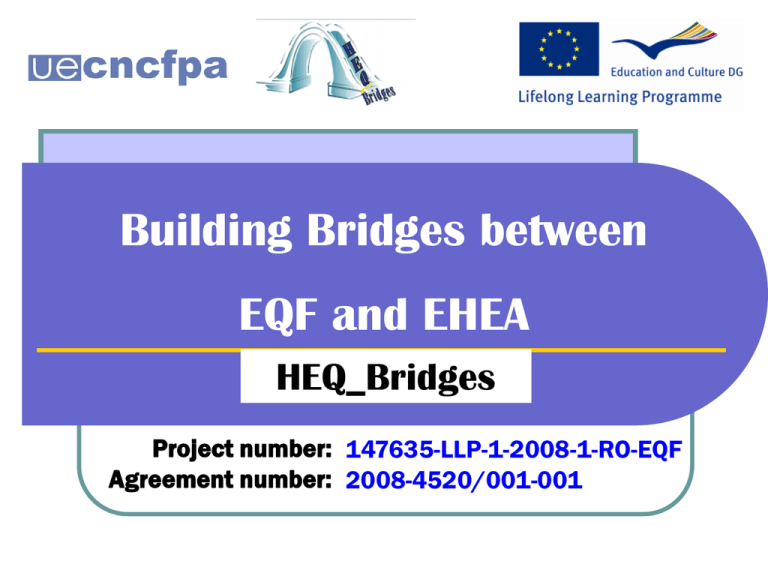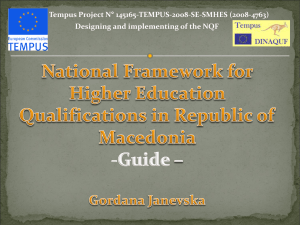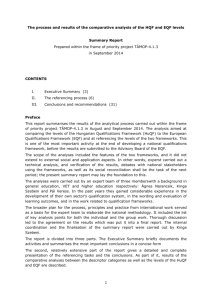UECNCFPA - Cedefop
advertisement

Building Bridges between EQF and EHEA HEQ_Bridges Project number: 147635-LLP-1-2008-1-RO-EQF Agreement number: 2008-4520/001-001 Parteners P1 - Executive Unit of National Council of Qualifications and Adults’ Vocational Training (UECNCFPA) P2 - Dekra Akademie GmbH P3 - Universidad de Zaragoza P4 - Institut Universitaire de Technologie de Rouen P5 - Université de Versailles Saint-Quentin en Yvelines P6 - Institúid Teicneolaiochta Áha Cliath P7 - Kunsill Malti ghall-Kwalifiki P8 - Autoritatea Aeronautică Civilă Română P9 - Universitatea Politehnica Bucuresti P10 - Univerza na Primorskem, Fakulteta za management Koper Building Bridges between EQF and EHEA December 2010 – Thessaloniki UECNCFPA- The national authority for qualifications in higher education Executive Unit of National Council of Qualifications and Adults’ Vocational Training (UECNCFPA) is the national authority for the establishment of the national qualifications framework. UECNCFPA develops, manages and regularly updates NQFHE in partnership with education institutions and with economic and social partners. Building Bridges between EQF and EHEA December 2010 – Thessaloniki Implementation of NQFHE Define qualifications by means of learning outcomes On the base of NQFHE matrix 5-6 Professional Competences (mentioned in the Diploma Supplement) Core competences for a qualification Possible Occupations for a Higher Education Qualification Building Bridges between EQF and EHEA December 2010 – Thessaloniki Professional Competences Aeronautical engineering and management Building Bridges between EQF and EHEA December 2010 – Thessaloniki Professional Competences Aeronautical engineering and management Building Bridges between EQF and EHEA December 2010 – Thessaloniki Implementation of NQFHE Define qualifications by means of learning outcomes On the base of NQFHE Matrix 5-6 Professional Competences (mentioned in the Diploma Supplement) Core competences for a qualification Possible Occupations for a Higher Education Qualification Building Bridges between EQF and EHEA December 2010 – Thessaloniki National Qualifications Framework in Higher Education Matrix Building Bridges between EQF and EHEA December 2010 – Thessaloniki Implementation of NQFHE Define qualifications by means of learning outcomes On the base of NQFHE matrix 5-6 Professional Competences (mentioned in the Diploma Supplement) Core competences for a qualification Possible Occupations for a Higher Education Qualification Building Bridges between EQF and EHEA December 2010 – Thessaloniki Implementation of NQFHE Grid 1 bis- A tool for each faculty Grid 1 Bachelor Grid 1 Master Grid 1 Doctorate Building Bridges between EQF and EHEA December 2010 – Thessaloniki Grid 1B – Description of study programme/field by means of professional and transversal competences Building Bridges between EQF and EHEA December 2010 – Thessaloniki Implementation of NQFHE Grid 1 bis- A tool for each faculty Grid 1 Bachelor Grid 1 Master Grid 1 Doctorate Building Bridges between EQF and EHEA December 2010 – Thessaloniki Grid 1 bis – Specific elements of study programme/field description Building Bridges between EQF and EHEA December 2010 – Thessaloniki Project Results 1.Comparative Assessment of National HEQS Products: 7 national reports, one comprehensive Report based on the input received/information found, validated by partners; Deliverable: Diversity and Comparability in the Implementation of National Qualifications Frameworks for Higher Education http://www.heqbridges.eu/index.php?option=com_rokdownloads&view=folder&Itemid= 9&id=8:wp2diversityandcomparability Building Bridges between EQF and EHEA December 2010 – Thessaloniki Project Results 2. European Journal for Qualifications Building Bridges between EQF and EHEA December 2010 – Thessaloniki Project Results Study cases in sectors: 1.Air transport 2.Mechatronics Building Bridges between EQF and EHEA December 2010 – Thessaloniki Air Transport 1. Aviation Jobs - Different ways to obtain the required competences in the air transport sector. Annex 1 Building Bridges between EQF and EHEA December 2010 – Thessaloniki Air Transport 2. Descriptors for sector qualifications - Annex 2 A. Aerodrome management 1. Aerodrome operations staff 2. Aerodrome infrastructure staff 3. Aerodrome maintenance staff 4. Aeronautical inspectors involved in aerodrome safety and certification Building Bridges between EQF and EHEA December 2010 – Thessaloniki Air Transport 2. Descriptors for sector qualifications - Annex 3 B. Air traffic controllers (ATCOs) 1.Air traffic controllers providing Aerodrome (TWR) control service 2. Air traffic controllers providing Approach (APP) control service 3. Air traffic controllers providing Area (ACC) control service 4. Air traffic controllers providing Aerodrome (TWR) control service, Approach (APP) control service or Area (ACC) control service - SUPERVISORS Building Bridges between EQF and EHEA December 2010 – Thessaloniki Conclusions The aerodrome staff needs a basic engineering training in aviation or in one of the aerodrome rated areas, such as electrical engineering, civil engineering, communication and data transmission, etc. The basic training should be completed with professional training for each specific aerodrome working area. Under specific circumstances the engineering training can be replaces with equivalent professional training such pilot training, air traffic controller training or military operational training. Building Bridges between EQF and EHEA December 2010 – Thessaloniki





